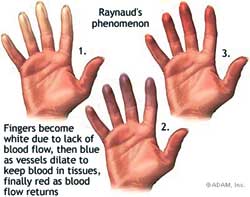
Blowing hot, blowing coldRemember the last time you put your hands in icy cold water? Remember how painful your hands felt when they were warming up? Well, this is what it can feel like for someone with Raynaud's. What is Raynaud's? Raynaud's is a condition first described by Maurice Raynaud in 1862 and is thought to affect as many as 10 million people in the UK. It's either described as primary, the commonest form, where there is no apparent cause, or secondary, where it is associated with underlying diseases. Examples of these diseases include scleroderma, rheumatoid arthritis, Sjorgren's syndrome, and systemic lupus erythematosus.
Scleroderma, also known as systemic sclerosis, is a connective tissue disease and, in the worst complications, has a death rate similar to lung cancer. Raynaud's affects nine times as many women as it does men. It can be hereditary and, when this is the case, it tends to be a milder form. It's quite common in teenagers, however many of those affected are only troubled for a few years and then it disappears when they're in their early 20s. Temperature change A simple change in temperature or stress interrupts the blood supply to the extremities. It's usually the fingers and toes that are affected, but the ears or nose can be involved too. When it happens, the skin turns deathly white, for some people it then turns blue, and then it becomes bright red. At this final stage, severe pain and sometimes numbness or tingling are the unpleasant consequences. Unfortunately, having Raynaud's can mean people avoid doing everyday things for fear that exposure to the temperature change will trigger their symptoms. Going out in cold weather is an obvious example and people with Raynaud's are usually prepared for attacks when they're outside. However, it comes as a shock to learn the hard way that just popping the hands in the fridge or holding a cold drink is all it takes, since the temperature changes don't necessarily need to be outdoors. Those who experience mild attacks usually only need to ensure they avoid temperature changes and wear warm clothing to protect them from the cold. |
|| Front
Page | News | Editorial | Columns | Sports | Plus | Financial
Times | International | Mirror | TV
Times | Funday
Times | Medi Scene || |
| |
Reproduction of articles permitted when used without any alterations to contents and the source. |
© Copyright
2007 | Wijeya
Newspapers Ltd.Colombo. Sri Lanka. All Rights Reserved. |
